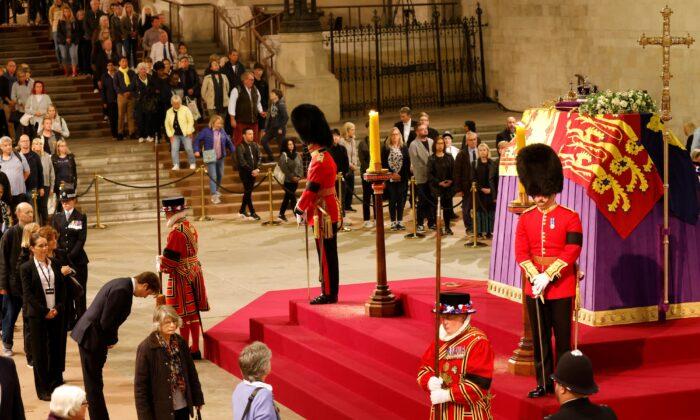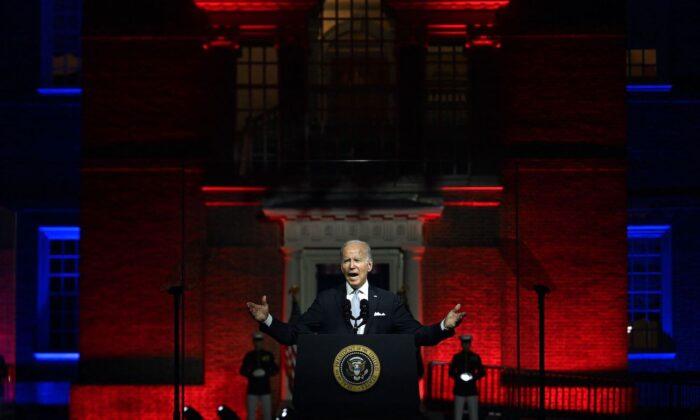As Queen Elizabeth II lay dying in Scotland, I was moved by the sight of ordinary people who had heard the news of her serious condition gathering and holding a vigil outside of Buckingham Palace in London. There were many smartphones and much clicking and flashing. But all fell silent as people watched the Union flag slowly lowered to half-mast before the official announcement of the queen’s death.
I recalled my first sight of Elizabeth—still a princess—as she drove past our school as we young English boys lined the sidewalk and waved our small union jacks. Just a couple of years later, my parents bought a small black-and-white TV set so we could all watch the queen’s coronation, televised live for the first time, in June 1953. I was 10 at the time and was enthralled with the pageantry and the endless parade of troops from all over the world, especially the Royal Canadian Mounties, which I aspired to join.
Not long after, I wrote to the governor general of Canada to offer my services. His reply—on official letterhead that I treasured for years—gently detailed the minimum height and weight requirements and suggested that I reapply in a few years.
Tradition
Today’s anti-monarchists complain about its cost to taxpayers, while supporters point to the institution’s benefits to the economy as a tourist attraction. Framing the issue of monarchy in terms of a cost-benefit analysis risks missing the significance of the British monarchy for the country and the Commonwealth of nations. Here I want to focus on tradition and the sacred, two underappreciated aspects of the British monarchy.Such a solemn occasion as the death of the Sovereign, followed immediately by her heir’s accession to the throne and next year by his coronation, is an important part of British tradition.
“Tradition,” as G.K. Chesterton put it, “is the democracy of the dead.”
It links us across generations and centuries, the living, those who have died, and those yet to be born.
Today’s British monarchy is the result of a constitutional arrangement that evolved over a thousand years, evincing a sense of the sacred, not just common interest or shared values but, in principle at least, a common love of God and neighbor. The system of government we now call a constitutional monarchy—as opposed to an absolute monarchy or republic—wasn’t arrived at by a rational process in a national convention that examined the history and experience of different forms of government. It evolved from centuries of contestation between state and church, king and barons—through the Magna Carta (1215), the Civil Wars of 1642 to 1651 between parliamentarians and royalists, and the Glorious Revolution of 1688, in which the Catholic James II was deposed and replaced by the Protestant William of Orange and his wife Anne. The outcome was an unwritten constitution that put sharp limits on the rights of kings without denying that all authority comes from God.
It’s hard to watch the events following the Queen’s death without seeing the historically specific nature of the British constitutional monarchy. It’s an institution that not only coexists with parliamentary democracy but also enables and fortifies it.
As I write, silent throngs of ordinary people are queueing for hours (22 hours is the current estimate) in the cold and making their way across miles (more than five miles at present) to pay their respects to the late queen, a sovereign with no real power. People are deeply moved, often unexpectedly, as they descend the steps of Westminster Hall in absolute silence to file past the dead monarch. Her coffin is draped with the royal standard and protected hour by hour by guards in full ceremonial—and traditional—uniform. Some bow or curtsy; some kneel and say a quick prayer. The lying-in-state will continue 24 hours per day until her funeral on Sept. 19.
Religion and the Sense of the Sacred
There’s a religious element to all this that most public commentary ignores. It’s true that few English people attend Church of England services or adhere to its doctrines.“Devotion, of course, has a religious significance. In largely secular, godless Britain there is a strong element of the sacred in this relationship between the people and the Crown.”
The queen’s coronation, like those of her predecessors, was a religious ceremony, a service celebrated by the Archbishop of Canterbury at which she swore an oath before God, received Communion, and was anointed as monarch, consecrated to a higher king.
As Phillips wrote, “The British monarchy is patterned on ancient Israel. It’s why the monarch is anointed; it’s why words uttered by ‘Zadok the Priest,’ taken from the first Book of Kings, have been sung at every English coronation since 973 C.E.”
How can this work in a country in which most people don’t attend religious services, even though if pressed they'll identify as Church of England and many use churches or temples for baptisms, marriages, and funerals but otherwise, as the saying goes, not darken a church door?
Liberal churches and congregations have sought to prove their “relevance” by adapting to the times, changing and conforming their teaching and practice to the prevailing orthodoxies of secular liberalism. The result has been to not fill pews but to empty them.
The events following the Queen’s death include pomp and pageantry, royals and dignitaries, the masses waiting in line, and those watching hours of continuous programming on television act out the unwritten British constitution in front of a nation and an audience blissfully unaware of its processes and principles. It’s a transition from one monarch to another, something that happens immediately upon the queen’s death before any ritual or ceremony.
The ceremonies of grieving and accession of a new monarch also enact a complex liturgy with roots in ancient Israel. Its development spans many centuries. They offer hope for the future as well as respect for past generations.
Dalrymple sees the ugliness in modern architecture and art, not least in modernist church buildings and music, as well as soulless city centers built on the willful destruction of ancient buildings. In such a world, people hunger in the millions for beauty and meaning.
I see that as well, but also detect, I think, in the people’s grief and mourning a hope and a need to recover their own lost sense of the sacred.





